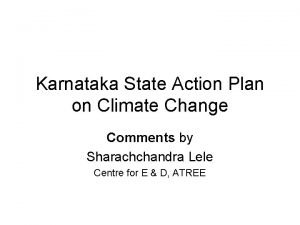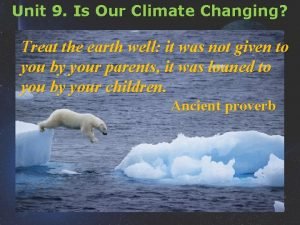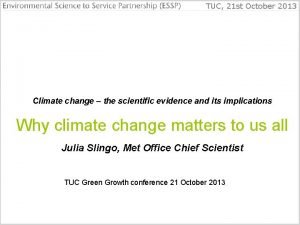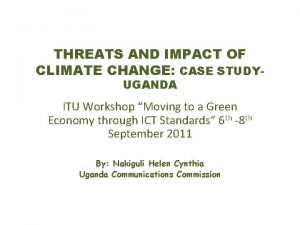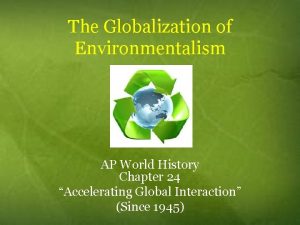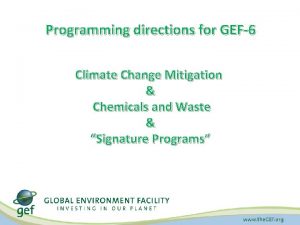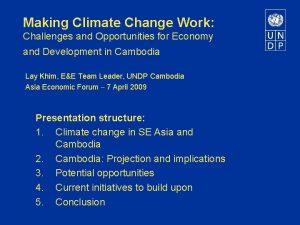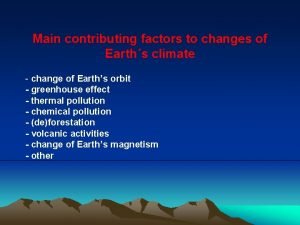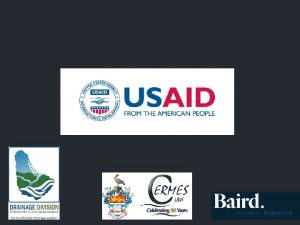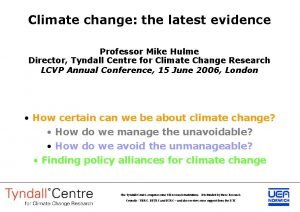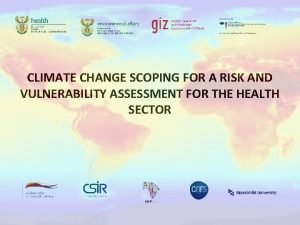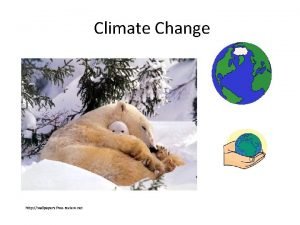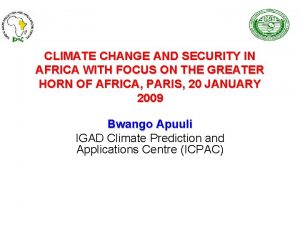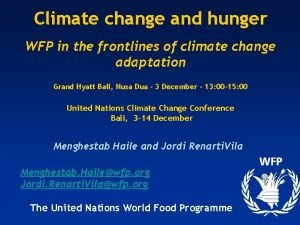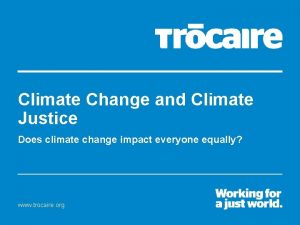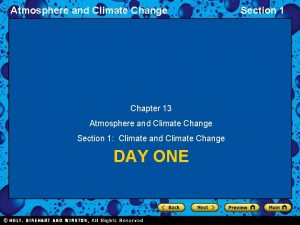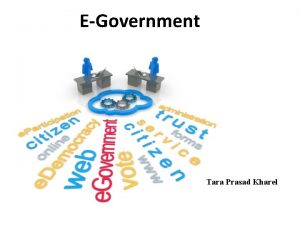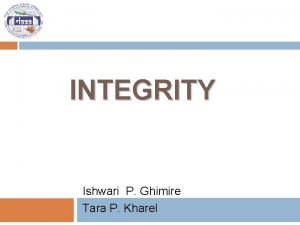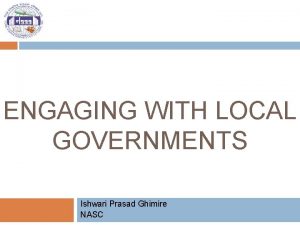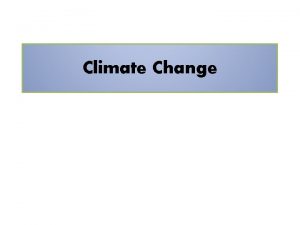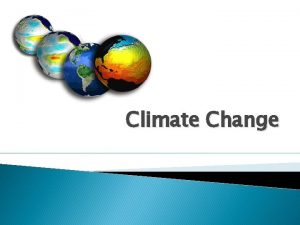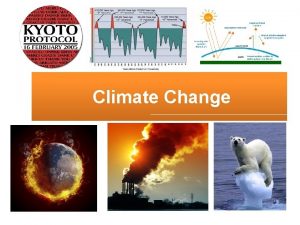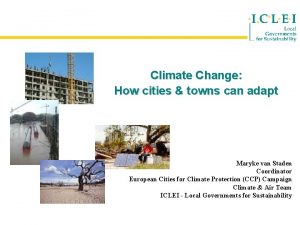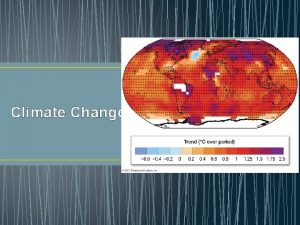CLIMATE CHANGE NASC Tara Prasad Kharel 2 2021






























- Slides: 30

CLIMATE CHANGE NASC Tara Prasad Kharel

2 2021 -09 -17

3 Face the Music : Climate Change 2021 -09 -17

Your Views in Climate Change 4 What is climate change? Why and where is it ? Who are affected more? 2021 -09 -17

5 Physical processes regulating climate 2021 -09 -17 Source: IPCC 5 th Assessment Report

Change in climate systems 6 Causes of Change in climate Systems: �within its own internal (energy) dynamics �due to changes in external factors External forcing includes: �volcanic eruptions �variability in the sun’s radiative output �changes in the concentration of greenhouse gases 2021 -09 -17


Observed Global effect 8 Global average sea level rose at an average rate of about 3. 1 (2. 4 to 3. 8)mm per year in a decade. Annual average Arctic sea ice extent has shrunk by 2. 7 (2. 1 to 3. 3)% per decade, with larger decreases in summer of 7. 4 (5. 0 to 9. 8)% per decade. Mountain glaciers and snow cover on average have declined in both hemispheres. 2021 -09 -17

9 2021 -09 -17

Tsho Rolpa Glacier 10 2021 -09 -17

Climate Change Situation in Nepal 11 Different Studies indicated an increase in temperature at an annual rate of 0. 06ºC Over the last 100 years, the warming in the Himalayas has been much greater than the global average of 0. 74 ºC (Du et al. 2004; IPCC 2007). Glaciers in the Himalayas of Nepal are retreating at a faster rate than before( 30 -60 meter between 1970 -1989) and thinning of the glacier surface is by 12 meter between 1978 -1989 (Nakawo et al. , 1997; Ageta et al. , 2001; Bajracharya et al. , 2007). 2021 -09 -17

Climate Change Scenario in Nepal 12 OECD – mean annual temperature to increase by an average of 1. 20 C by 2030, 1. 70 C by 2050 and 30 C by 2100 against the baseline using the GCMs run with SRES B 2 scenario NCVST - mean annual temperature to increase by 1. 40 C by 2030, 2. 80 C by 2060 and 4. 70 C by 2090 using GCM and RCM NCVST - higher increment of temperatures in western and central Nepal compared to eastern Nepal for the year 2030, 2060, and 2090 OECD - Organization for Economic Co-operation and Development GCM – Global circulation model SRES - Special Report on Emission Scenarios 2021 -09 -17

Now Think 13 What will be the Effect of Climate Change in Project? 2021 -09 -17

14 2021 -09 -17

South Asia? 15 � 1 � 2 � 3 � 4 � 5 - Bangladesh (1) India (2) Nepal (4) Afghanistan (8) Pakistan (16) 2021 -09 -17

Think 16 What will be the outcome of the project due to climate change? 2021 -09 -17

A story of frog 17 2021 -09 -17

Adaptive capacity 18 Livelihood assets Social Resource and Hazard Mapping Livelihood Assets Analysis Institutional Analysis Indicators Development - Human Development Index Livelihood Strategies - Non Agricultural Livelihood Strategies, Absentee Population Social Network - Number of working NGOs 2021 -09 -17

19 2021 -09 -17

IPCC Criteria for VA 20 Character of Climate Change Magnitude of impacts, Timing of impacts, Persistence and reversibility of impacts, Likelihood (estimates of uncertainty) of impacts and vulnerabilities, and confidence in those estimates, Potential for adaptation, Distributional aspects of impacts and vulnerabilities, 2021 -09 -17 Importance of the system(s) at risk.

Indicators of CC Impacts 21 Agriculture & Food Security Water Resources and Energy Climate Induced Disaster Forest & Bio-diversity Urban Settlement & Infrastructure Public Health GESI Hydro-meteorological parameters (Temperature, Precipitation, Humidity) Others 2021 -09 -17

National Need for CC Adaptation 22 Micro-level analysis and mapping of Climate Impacts and Vulnerability Reducing knowledge gaps on climate change Prioritization of adaptation into Developmental processes Financial and Institutional capacity building for integration of adaptation in development process 2021 -09 -17

National Effort 23 Sustainable Development Agenda (SDAN) , 2003 Climate Change Council, 2009 Mountain Initiative 2009 Climate Change Management Division, 2010, Mo. Env NAPA, 2010 Climate Change Policy, 2011 Climate Resilient Planning Tool , 2011: NPC Local Adaptation Plan of Action (LAPA), November 2011 The Constitution of Nepal 2015 2021 -09 -17

NAPA 24 Urban Settlement and Infrastructure Agriculture and Food Security Climate- Induced Disaster Public Health Forests and Biodiversity Water Resources ad Energy 2021 -09 -17

LAPA Framework 25 2021 -09 -17

Climate Change Response: (IPCC, 2001) 26 2021 -09 -17

Steps in the CRM Process 27 Step 1 – Setting the Context � Project location and components, Current climate, History of extreme events, Climate change projections Step 2 – Analyze the Risk – No/Low/Medium/High Step 3 – Analyzing the Hazard � Detail climate change hazards, Frequency of events, Project impacts Step 4 – Frequency and Probability - Evaluate probability and severity Step 5 – Evaluate the Risk - Determine the risk to the project from Step 4 Step 6 – Adaptation Plan - Describe actions to be taken to 2021 -09 -17 address climate change impact

Steps for Responding CC 28 Knowledge/information - Understanding climate risk and resiliency of Project Understanding vulnerability Planning for prioritizing actions, mobilizing resources Execution of the plan, monitoring and feedback 2021 -09 -17

29 Adaptation Iceberg 2021 -09 -17

30 Thank you 2021 -09 -17
 Climate change 2014 mitigation of climate change
Climate change 2014 mitigation of climate change Kumar raj kharel
Kumar raj kharel Prin ce se înmulțesc animalele
Prin ce se înmulțesc animalele Root viv
Root viv Nasc root word examples
Nasc root word examples Nasc compliance sheet
Nasc compliance sheet Tg20 15 free download
Tg20 15 free download Persuasive essay about global warming
Persuasive essay about global warming Karnataka state action plan on climate change
Karnataka state action plan on climate change Climate types brainpop
Climate types brainpop Climate change meaning and definition
Climate change meaning and definition Chapter 13 atmosphere and climate change section 1
Chapter 13 atmosphere and climate change section 1 Unit 9 climate change
Unit 9 climate change Conclusion of climate change
Conclusion of climate change Youreuropemap.com
Youreuropemap.com Conclusion of climate change
Conclusion of climate change Mathematics of climate change
Mathematics of climate change Globalization definition ap world history
Globalization definition ap world history Climate change mitigation
Climate change mitigation 414 climate change
414 climate change Conclusion of climate change
Conclusion of climate change Factors of climate change
Factors of climate change Human causes of climate change
Human causes of climate change Example of conceptual framework in accounting
Example of conceptual framework in accounting Uk climate change
Uk climate change Climate change interview
Climate change interview Factors effecting climate change
Factors effecting climate change Conclusion of climate change
Conclusion of climate change Conclusion of climate change
Conclusion of climate change Climate change causing droughts
Climate change causing droughts Chapter 13 atmosphere and climate change
Chapter 13 atmosphere and climate change








